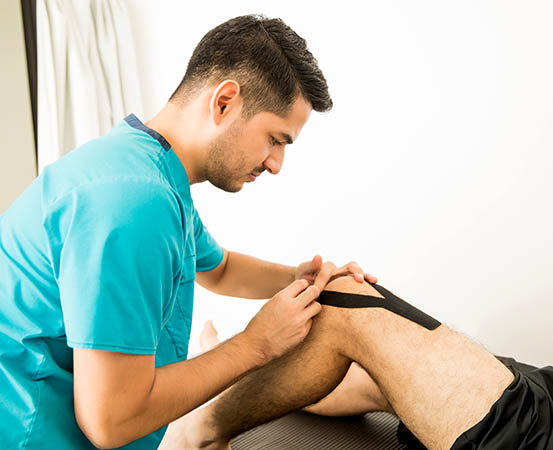
Anterior cruciate ligament (ACL) tear is a common injury of the knee joint prevalent among active individuals and sportspersons. The injury is accompanied by pain, swelling and instability of the knee.
ACL tears are classified as grade I, II and III based on the extent of the tear – grade III being a complete ACL tear, with or without associated meniscal/ posterior cruciate ligament (PCL)/lateral injuries. The others are partial tears which can be treated with physical rehabilitation or ACL augmentation surgery. Complete tears call for reconstruction surgery (arthroscopy), followed by dedicated rehabilitation.
Irrespective of whether one opts for surgery, rehabilitation is mandatory for complete recovery, return to function and prevention of re-injuries or associated postural and joint stability issues. One must consult a doctor or a physical therapist and work with them to develop a personalised rehabilitation plan.
“Patients who have undergone surgery can be ambulated [made to walk] the following day in the hospital itself, under the physiotherapist’s supervision,” says Archita Tiwari, a senior physiotherapist and director of Rehabics Physiotherapy, Bengaluru. “This is followed by home visits and self-exercises [three to four times a day]. Otherwise, it can lead to vascular issues like deep vein thrombosis [DVT].”
Improper or insufficient rehab “can result in muscle atrophy, joint stiffness or lax [bent] knees [during movement], which is also called fixed flexion deformity or extension lag,” adds Tiwari, before listing out a typical routine of rehabilitation exercises for ACL tears:
1. Ankle pumps
Stretch out the ankle away from the body. Relax it back to normal position and repeat the process. This is recommended both before and after the surgery as it aids circulation and flexibility, along with preventing blood clot formation due to immobility.
2. Straight leg lifts
Lie on your back, slowly raise your leg straight up towards the ceiling and then lower it back down. This is done by wearing a long knee brace for about two weeks and then practicing without it.
3. Walking
Walk with a long knee brace initially to avoid bending of the knee, while also taking the support of a walker. Gradually progress to using a walking stick and then eventually walking without it.
4. Gradual bending of the knees
The normal range of motion (flexion) of the knee is 140 degrees. An injury causes excessive swelling and pain, which impairs this range significantly. In the initial days following injury, it is advisable to achieve 45 to 90 degrees of bending, which can be gradually increased to 120 degrees in a month’s time.
5. Activation of quads and hamstrings
- Quad sets: This exercise involves tightening the front thigh muscle (quadriceps) for five to ten seconds and then relaxing it for the same amount of time. 10-15 repetitions (reps) should be done.
- Hamstring curls: Lie on your stomach and pull your heel towards your buttocks. Repeat 10-15 times for each leg.
6. Exercises with electric muscle stimulation (EMS)
Electric muscle stimulation (EMS) is a form of therapy that stimulates muscle contraction using electrical impulses. It strengthens muscles, aids the healing process, reduces swelling and relieves pain. Physiotherapists recommend straight leg lifts, followed by static and dynamic quad sets in the presence of EMS.
7. Bending and straightening of the knee
While sitting on a chair or the edge of the bed, hold one leg straight out and slowly lower it, bending it at the knee. Repeat the same process for the other leg. 10-15 reps should be done for each leg.
8. Loading exercises
These are done 15 to 20 days post-surgery or injury:
- Double leg stance: While standing on both legs, gradually shift the weight onto the affected leg for a few seconds, and then return to the original position. Repeat the process.
- Single leg stance: Stand on one leg, holding on to a support nearby. Repeat the same for the other side. Once balance is achieved, gradually progress to using a Bosu ball (appears as a swiss or gym ball cut in half, used for balance training).
9. Step-ups
Step onto a stepper or stand at the foot of the staircase, and slowly practice climbing up and down a single stair. As confidence builds, one can increase the pace.
10. Functional training
Practise squats and lunges. Start with wall squats and gradually progress to normal half squats by taking the support of a medicine ball (gym ball) between your back and the wall (or a chair).
11. Neuromuscular training and proprioception exercises
Physiotherapists design certain simple as well as complex functional exercises in the gym to train one’s coordination and balance.
12. Agility training
This includes running, jogging, jumping and sport-like activities. It helps one to train deceleration or the reflex to stop suddenly if required.
13. Sport-specific training
This form of training is designed for athletes, where physiotherapists assign activities to regain the athlete’s respective sport skills. For instance, footballers are made to practice running and kicking a ball.
14. On-field training and return to sport
Training on the field (which can be uneven) is important as training at the gym does not provide the same experience.
“These exercises can be taken to the next level by using weights (like ankle weights) to further train for strength,” says Tiwari. “Pre-surgery strengthening is as important as post-surgery rehabilitation. The first four to eight weeks post ACL surgery are also crucial. That is when utmost care and supervision is necessary.”
The average recovery time depends on the intensity of the physical activity.
“One should perform the exercises consistently to make an effective progression towards pre-injury levels of strength and functionality,” says Tiwari. “This can mean up to six months of rehab for moderately active individuals, and nine months to a year for a safe return-to-play for athletes.”

















